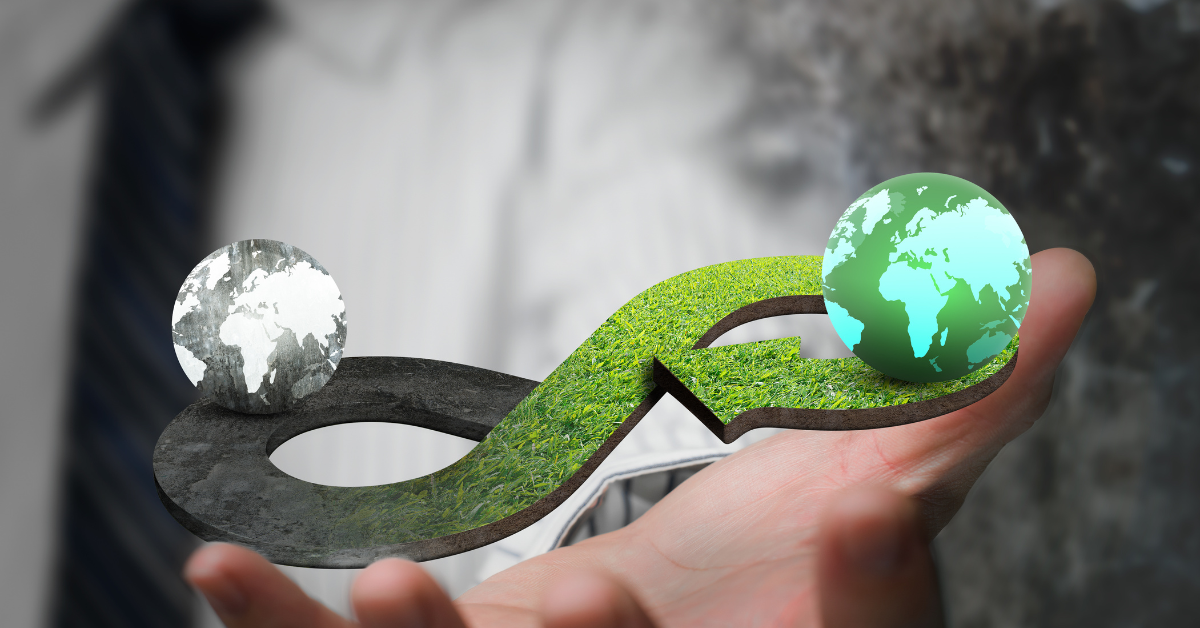
Circular Economy: In the round
Opinions expressed whether in general or in both on the performance of individual investments and in a wider economic context represent the views of the contributor at the time of preparation.
Executive summary: At least $2tr of value could be unlocked globally by the middle of this century through the embrace of more circular economy principles. Despite no consistent definition of the term, with less than 10% of all material produced annually being recycled at present, the opportunity is significant. Nearly every developed world government and business has correspondingly begun to recognise the importance of having a more circular economy. Tangible progress can be seen in sectors as diverse as consumer goods, electronics, autos and construction. Although future advances will not be linear, optimists believe that the transformation from linear to circular could be rapid. Few thought that the car would replace the horse within 15 years, during which time a whole new infrastructure was put in place. The same might be possible for the circular economy. From an investment perspective, there are multiple opportunities.
We have a big problem: we’re taking too much and wasting too much. Put another way, we’re using more than the Earth can provide. In the last 50 years, the world’s consumption of raw materials has nearly quadrupled, to more than 100bn tons. As a consequence, the planet is using about 60% more of the earth’s resources than it can regenerate each year. By 2050, with an increased global population resulting in a rise in consumption, this ratio could grow by a factor of at least five (all data per the World Economic Forum). Over-extraction clearly harms people, the planet and economies. The good news, at least, is that there are solutions at hand.
Another way of demonstrating the magnitude of the problem is to consider just how much waste the world produces. Annually, it is equivalent to over 3,500 Empire State Buildings, or ten times the entire weight of Manhattan Island (per the World Bank). Nearly all of this ends up in landfills. If it doesn’t find its way to a landfill, then the waste may land in the ocean. The equivalent of one dump truck of plastic alone is tipped into the ocean every minute, every day. On an annualised basis, the total weight of this plastic would be equivalent to 90 aircraft carriers (per Pew Research). Extrapolating from this, by 2050, there will be more plastic by weight in the ocean than fish.
Less than 10% of all material produced is recycled annually (per the World Economic Forum) – hence the logic for a more circular economy. The concept of a circular economy stands in distinct contrast to the more traditional linear economy. Although definitions for the circular economy vary, typically three principles are required for linear economies to transform to more circular ones: the elimination of waste and pollution; the circulation of products and materials; and the regeneration of nature.
A circular economy is not the same thing as recycling. The two ideas are related, but a circular economy is more systematic and ambitious. Think of it as a model of economic, social and environmental production and consumption that aims to build an autonomous and sustainable society in tune with the issue of environmental resources; a resilient, distributed, diverse and inclusive economic model.
The concept is far from novel, first developed in the 1960s and present in economic literature since the late 1980s. However, it is only within the last decade that the circular economy idea has gained traction in academia, business and government. At a government level, a more circular economy can be viewed as a means of combating global warming as well as a facilitator of long-term growth. It could also enable local job creation and reduce geopolitical risks.
The UN’s Platform for Accelerating the Circular Economy (or PACE) calls for a global commitment to double circularity every ten years. PACE has mapped over 200 possible actions that governments could take, centred around materials recirculation, materials efficiency and new business models. To quantify this benefit, the UN believes that the effective implementation of such actions and more judicious use of resources could add $2tr to the global economy by 2050. Some consultants see the opportunity as being potentially even more significant, with Accenture calculating that better waste management could unlock $4.5tr of global value by 2030.
The scope for where circular economy policies and initiatives can be implemented is broad, including products, infrastructure, equipment and services. It covers both ‘technical’ resources (metals, minerals, energy inputs) and ‘biological’ resources (food, fibres, timber etc.) and applies to every industry sector. Below follow some of the most tangible examples of circular economy initiatives currently underway.
Begin with the FMCG (or fast-moving consumer goods) sector. Accenture’s analysis finds that the industry could capture up to $300bn by 2030 by optimising its packaging for circularity. The use of virgin plastics has already fallen significantly but can reduce further. Nestlé, the world’s largest packaged-food company, has pledged to make 100% of its product packaging recyclable or reusable within the coming decade. Other companies including Kellogg, Kroger, L’Oréal. Pepsi, Unilever and Walmart have made similar plastic pledges. Coca Cola already uses 100% recycled PET bottles in several geographies, while both McDonalds and Starbucks state that all their packaging globally now comes from renewable, recycled or certified sustainable sources. Another impressive initiative is being pioneered by Ikea. It has said that by 2030 it will seek to design products made only from renewable and recyclable materials.
The textile industry is a different sector ripe for implementing more circular principles. For every five garments produced, the equivalent of three end up in a landfill or are incinerated each year. Some 148m tons of clothing each year are thrown away (all data per McKinsey). Major brands, including H&M, Adidas and Nike, are responding. H&M has committed to using 100% recycled or sustainably sourced materials by 2030; Adidas currently offers more than 450 products across its range that are made from recycled ocean litter and Nike has instituted a Sustainable Manufacturing and Sourcing Index. This works to incentivize and reward improved environmental, health, safety, and labour practices at the factories along its supply chain. A number of industry players and start-ups are also experimenting with new business models including subscription/ rental options, repair and enhanced resale.
Another industry where significant waste is generated is electronics and electric goods sector. We currently throw away more than 50m tons of merchandise annually, worth at least $60bn. This includes over 6kg per capita of valuable materials such as gold, silver and rare earths. Less than 20% of e-waste is formally recycled, with the remainder ending up either in landfill or being informally recycled, much of it by hand in emerging markets, exposing workers to hazardous and carcinogenic substances (all data per the United Nations). Solutions include bans of the destruction of unsold electronic products (introduced in France), offering closed loop services for mobile phones with materials recycled on a like-for-like basis into new handsets (such as in the Netherlands, where repurposed handsets get sent to emerging markets) and up-cycling old IT equipment. Additionally, large electronic goods players such as Electrolux and LG are all repurposing materials from old goods into new products.
Many of these arguments also apply to the auto industry. Although the shift towards electric vehicles (EVs) is helpful from a secular perspective, do not forget that the costliest part of an EV is its battery. These comprise materials such as lithium, cobalt, manganese and nickel, all of which may have long and complicated supply chains. Against this background, there is a clear logic for auto businesses to develop and/or partner with those developing gigafactories. These are designed with recycling in mind from the start. When batteries reach the end of their lives, their ingredients can be recovered and put into new batteries. Renault and Stellantis (the name for the merged Fiat-Chrysler PSA group) have both said that they believe up to 85% of future vehicles could be recyclable, while BMW has gone a step further; its iVision electric vehicle is designed to be built from 100% recycled materials.
One final industry worth considering is the construction sector, a significant waste generator. Global demand for construction materials has grown alongside population and economic development. Manufacturing new materials consumes energy and resources, while many existing materials end their life cycle in landfill. Circular economy solutions include the deconstruction of end-of-life buildings, more modular construction systems and buildings made from new resources such as timber. Trees store carbon, provide better insulation, can be recycled and avoid the use of concrete. Finland has been a pioneer in this respect. Over 15% of commercial buildings constructed in this country now comprise wood as a key material.
Concepts and commitments may be one thing and achieving workable circularity may sound simple, but in practice, it can prove dauntingly complex. It demands more than encouraging recycling, repair and reusing. Rather, it requires rigorous environmental and social cost-benefit analysis. Trying to reach a 100% recyclability rate might prove counter-productive if the price of recovery remains higher than the value of the materials recycled. The circular economy may also suffer from a similar rebound effect to energy-efficient strategies. Just as more efficient coal plants can lead to lower coal prices and therefore higher demand for coal, more efficient use of materials could make some products cheaper and more appealing. While technical changes succeed in lowering the per-unit impact, overall the environmental benefit is largely offset by economic growth.
This opens up a broader debate over whether the aim of a more circular economy is to promote well-being or GDP growth (or whether the two are even mutually exclusive). What makes sense environmentally may not always do so for individual companies or regions. Natural casualties would be purveyors of fossil fuels, minerals, agricultural produce and other primary materials. Do not also forget the (potentially valid) charge of ‘greenwashing.’ Many companies may be guilty of focusing on improving their brand image over fundamentals. Accenture estimates that over 90% of companies with net zero commitments will miss their targets.
If a case for optimism were to be made, then it is simply that the shift from a linear to a circular economy could occur as quickly as the shift from cart-horse transportation to the motor vehicle. This took less than 15 years, although it seemed entirely inconceivable at the time. Over this period, an entirely new infrastructure (paved roads, petrol refining, service stations, automotive supply chains etc.) was put in place. The same may occur this time around, especially when over 70% of consumers polled by the National Retail Federation say that they would be willing to pay a premium for circular products.
From an investment perspective, there are multiple ways of getting exposure to the circular economy theme. Beyond the private sphere, the handful of quoted ETF products that offer access to this tend to provide an indication of just how diverse the opportunity within the listed space is. Businesses that fall under the circular umbrella could be any that can be seen to be embracing more circular principles, whether in the electronics, materials or FMCG sectors. Other candidates include pure-play waste businesses (for example, Waste Connections, Waste Management), direct recycling plays (such as Tomra) and those producing products from entirely sustainable materials (like SIG). The latter, listed in Switzerland and capitalised at CHF8bn is a leading global supplier of sustainable packaging solutions based around aseptic cartons. Dig deeper though and the scope of the circular economy opportunity becomes more visible. Almost every business within our universe – from Airbnb to Zebra Technologies is embracing circular principles. Our next sustainability report (due in April) will address this topic in even more detail.
Alex Gunz, Fund Manager, Heptagon Capital
Disclaimers
The document is provided for information purposes only and does not constitute investment advice or any recommendation to buy, or sell or otherwise transact in any investments. The document is not intended to be construed as investment research. The contents of this document are based upon sources of information which Heptagon Capital LLP believes to be reliable. However, except to the extent required by applicable law or regulations, no guarantee, warranty or representation (express or implied) is given as to the accuracy or completeness of this document or its contents and, Heptagon Capital LLP, its affiliate companies and its members, officers, employees, agents and advisors do not accept any liability or responsibility in respect of the information or any views expressed herein. Opinions expressed whether in general or in both on the performance of individual investments and in a wider economic context represent the views of the contributor at the time of preparation. Where this document provides forward-looking statements which are based on relevant reports, current opinions, expectations and projections, actual results could differ materially from those anticipated in such statements. All opinions and estimates included in the document are subject to change without notice and Heptagon Capital LLP is under no obligation to update or revise information contained in the document. Furthermore, Heptagon Capital LLP disclaims any liability for any loss, damage, costs or expenses (including direct, indirect, special and consequential) howsoever arising which any person may suffer or incur as a result of viewing or utilising any information included in this document.
The document is protected by copyright. The use of any trademarks and logos displayed in the document without Heptagon Capital LLP’s prior written consent is strictly prohibited. Information in the document must not be published or redistributed without Heptagon Capital LLP’s prior written consent.
Heptagon Capital LLP, 63 Brook Street, Mayfair, London W1K 4HS
tel +44 20 7070 1800
email [email protected]
Partnership No: OC307355 Registered in England and Wales Authorised & Regulated by the Financial Conduct Authority
Heptagon Capital Limited is licenced to conduct investment services by the Malta Financial Services Authority.



